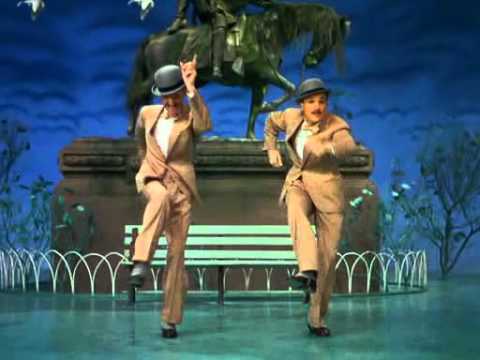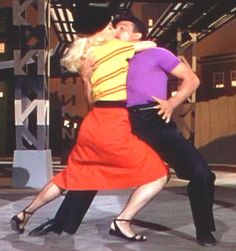It’s a Wonderful Life and Miracle on 34th Street are often listed as “must-see” films every year on various lists of classic Christmas films. And these films are fine. But they hardly rank on my list of films that I have to watch each year. Don’t get me wrong, I enjoy these films, I own these films; but honestly, they’re usually at the bottom of my pile when I exhaust all other possibilities and decide to not re-watch my absolute favorite Christmas film–White Christmas (1954) for the millionth time during the season. I usually end up watching White Christmas at least 3-4 times during the season. One year, I think 2018, I even saw it in the theater! That was amazing.
I absolutely love White Christmas. It is funny, it has great music, a great cast, a great plot, and great dancing! And, if that weren’t enough, it was also filmed in gorgeous Technicolor and presented in Paramount’s revolutionary (for 1954) VistaVision widescreen format. There were other technological innovations used in the production of this film including using larger negatives and prints that I don’t really understand, nor do I care. What’s important is that this film is absolutely gorgeous to watch.

The film opens on Christmas Eve, 1944 during World War II. Former Broadway star, Bob Wallace (Bing Crosby) and aspiring Broadway star, Phil Davis (Danny Kaye) are entertaining their fellow soldiers of the 151st Division. Bing (Bob) sings the perennial Christmas standard for which Bing Crosby will forever be associated and all other Christmas songs will be judged against–Irving Berlin’s “White Christmas.” “White Christmas” was originally introduced in 1942 for Holiday Inn, also starring Bing Crosby. In this film he co-stars with Fred Astaire. While “White Christmas” was introduced ten years prior, I believe that it is more associated with the 1954 film of the same name.
After Bob finishes singing, the troop receives word that their beloved General Waverly (Dean Jagger) is being relieved of his command. General Waverly arrives and says goodbye to his men. The men send him off with a song and then are bombed. Phil saves Bob from being crushed by a falling wall; but his arm is wounded in the process. This sets off a funny running gag throughout the film where Phil uses his arm injury as a means to guilt trip Bob into following his plan. Bob asks Phil what he can do to repay him for saving his life and Phil responds with the idea that he and Bob should team up as a Broadway duo. Bob is hesitant, but agrees.
PHIL: “My dear partner, when what’s left of you gets around to what’s left to be gotten, what’s left to be gotten won’t be worth getting whatever it is you’ve got left.”
BOB: “When I figure out what that means, I’ll come up with a crushing reply.”
National Treasure Danny Kaye and Bing Crosby in “White Christmas” (1954)

After the end of World War II, Bob and Phil go on the road and are a huge sensation. After a string of successes as performers, Bob and Phil turn to producing their own shows. They develop a new musical, called “Playing Around” and set off to cast it. One day, Bob and Phil travel down to Miami, FL to view “The Haynes Sisters,” a sister-act starring Betty (Rosemary Clooney) and Judy (Vera-Ellen) Haynes. It seems that the Haynes Sisters’ brother, Ben “Freckle Face” Haynes (Carl “Alfalfa” Switzer) was an old Army buddy of Bob and Phil’s and he wrote to them asking them to check out his sisters’ act.

After watching Betty and Judy sing “Sisters,” both Bob and Phil are smitten. Bob has his sights set on Betty and Phil has a crush on Judy. Phil, liking to play matchmaker, notices that Bob is ogling Betty. After the sisters’ performance, he arranges for the four of them to meet. Phil and Judy hit it off immediately and sing and dance a gorgeous duet, “The Best Things Happen When You’re Dancing.” It also comes out that it was Judy who wrote to Bob and Phil, not her brother.
PHIL (Looking at the Haynes’ Sisters’ brother’s photo): “How can a guy that UGLY have the nerve to have sisters?”
BOB: “Very brave parents, I guess.”
National Treasure Danny Kaye and Bing Crosby in “White Christmas.”
Between sets, the sisters’ landlord shows up and announces that he is suing them for the cost of a damaged rug. The sisters claim innocence, but the landlord isn’t having it. He’s even gone as far as to get the police involved. To get Betty and Judy away from the police, Phil gives them his and Bob’s train tickets (in a compartment, naturally) to New York. However, Betty and Judy need to perform one more set at the club. Bob and Phil go on in their places in a very funny, lip-synced rendition of “Sisters.” One can’t help but see how much fun Danny Kaye was having hitting Bing Crosby with the feather fan. At this moment, I am going to start referring to Danny Kaye as “National Treasure Danny Kaye” because imo, he is what holds this entire film together.

Bob and Phil escape to the train, where Bob discovers that Phil has not only given away their train tickets, but he’s also given away their beds. Much to Bob’s chagrin, he and Phil will have to spend the evening in the club car. Bob, Phil, Betty, and Judy reunite on the train. Betty and Judy inform Bob and Phil that they’re on their way to Vermont to perform at a ski lodge over the Christmas holiday. The girls invite the boys to come along. The boys agree and the foursome sings about snow.
When they arrive at the Inn, they discover that Vermont has received exactly 0″ of snow. So much for skiing or tourism. For me personally, I welcome any winter without snow, but I can understand how the lack of snow would hinder people’s ski holidays. Bob and Phil are shocked to discover that their beloved General Waverly is the proprietor of the Inn and sunk his entire life savings into it. If he can’t turn a profit on it this holiday season, he will go bankrupt. Seeing their friend in trouble, Bob and Phil set off to save the Inn.
BOB: “We came up here for the snow. Where’re you keepin’ it?”
EMMA: “Well, we take it in during the day!”
Bing Crosby and Mary Wickes in “White Christmas” (1954)
I can’t get enough “White Christmas.” I’ve seen it at least two dozen times and I never tire of it. All the music is fantastic. Aside from the title song, “White Christmas,” I also really love Rosemary Clooney’s solo number, “Love, You Didn’t Do Right By Me” and the Haynes Sisters’ song, “Sisters.” And though I detest snow, I love the “Snow” song that the group sings on the train. And like many of these films where they put together a show, none of the musical numbers seem to make any sense in the context of the show that they’re supposedly putting together.

In rehearsals, we see a Minstrel show with Vera-Ellen dancing to “Mandy.” Later, we see National Treasure Danny Kaye and Vera-Ellen dance to a song called “Choreography” where Kaye is some sort of flamboyant choreographer. Vera-Ellen dances to an instrumental version of the controversial “Abraham” song from “Holiday Inn.” Finally, we see the foursome perform “Gee, I Wish I Was Back in the Army” behind oversized, exaggerated cutouts of people in typical professions. All of these lead us into the fantastic, emotional finale where we hear a reprise of “White Christmas.”
None of these songs could possibly fit together into any sort of cohesive narrative. But it doesn’t matter. Because all the songs are fantastic and the dancing is fantastic.
PHIL (After kissing Judy): “You know, in some ways, you’re far superior to my cocker spaniel.”
National Treasure Danny Kaye in “White Christmas” (1954)
This film is so much fun to watch. It is funny, emotional, sad, happy, romantic, this movie has everything. I love National Treasure Danny Kaye and Vera-Ellen. Rosemary Clooney has such a beautiful singing voice and such a great style. I love Bing’s singing as well and I especially love his musician slang that he incorporates throughout the film. I love when he asks Betty to “bring the cow” (grab the pitcher of milk) over to the table where they are sitting. Mary Wickes, who plays General Waverly’s housekeeper, Emma, is hilarious. She’s often seen eavesdropping on phone calls and spreading misinformation.
EMMA: “Oh, my word. If I wasn’t such a mean old biddy, I’d break down and cry.”
Mary Wickes in “White Christmas” (1954)
Now excuse me, I’m off to watch “White Christmas” and National Treasure Danny Kaye.











